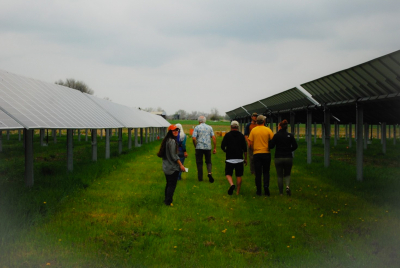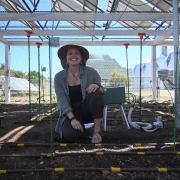Fostering Social Acceptance of Solar Through Agrivoltaic Solutions
By Alexis Pascaris
What if we shifted our perspective to view Not in My Backyard (NIMBY) syndrome as an occasion for innovation? What if we strategically integrated local community interests into a solar project, rather than grappling to override them? Luckily, embodying these ideals may not be as lofty as it seems.
Combining agriculture and solar energy production in an agrivoltaic system shows promise as a sensible method to reduce siting conflict, generate rural economic opportunity, and ultimately increase social acceptance of solar. The majority of the solar professionals interviewed in a recent study on industry perspectives about agrivoltaics discussed the great potential to leverage these systems strategically to retain local agricultural interests in project development and consequently gain receptivity in a community. Minimizing threat to existing community interests by pursuing a dual-use project provides a distinct advantage over traditional ground-mounted solar projects, which are often challenged on the basis of land conservation and farm preservation values.
But do solar energy deployment and farmland preservation have to be mutually exclusive pursuits? Can the agrivoltaic solution properly reconcile these competing interests in a way that benefits all stakeholders?

Let’s consider for a moment that we are at a delicate yet opportune inflection point in large-scale solar deployment. Previous case studies exemplify how the community relation component of project development has rippling consequences (both positive and negative) on our ability to sustain the build-out rate of solar. Poorly developed projects perpetuate lack of trust in developers, resistance from rural communities and ag-interest groups, as well as restrictive land use policy. Research concerned with New England’s energy transition evaluated the factors that contribute to energy project outcomes, finding that stakeholder relations is instrumental, and that social conflict is a key contributor to project failure. Collaboratively designed projects that generate co-benefits leave a legacy of community pride and positive perception about solar. The Long Island Solar Roadmap Project demonstrates how the solar development process can be enhanced through stakeholder engagement, which includes incorporating community preferences in project siting and design.
Based on precedence, the path of least resistance is clear – to meet our ambitious renewable energy targets, we must develop innovative, inclusive practices to minimize siting conflict and harmonize solar deployment goals with existing community interests. By upholding community values and agricultural interests in a solar project, agrivoltaics provide a means to enhance development practice remarkably well.
You may say I’m a dreamer, but I’m not the only one. Last spring, we surveyed two U.S. counties to investigate whether public support for solar increases when a project incorporates agricultural production. Survey respondents indicated that they would be more likely to support solar development in their community if it combined energy and agriculture. The study further investigated the importance of a range of planning and development factors – land type, distribution of project benefits, and impacts on local interests were determined to be of highest priority to community members when considering their support for a solar project. These findings imply the importance of community engagement in the planning process and suggest that a solar project designed to maintain the agricultural function of land is likely to experience receptivity rather than resistance – a valuable co-benefit of the agrivoltaic approach.
Thinking long-term about our commitments to sustain the deployment rate of solar not only includes optimizing economic and technical efficiency but fostering social acceptance as well. “Social acceptance” can either be our mighty ally, or a formidable opponent to our solar development pursuits. The agrivoltaic solution illuminates a pathway to alleviate siting conflict, generate localized benefits, and contribute to a legacy of solar projects everyone is proud of.
What if all future solar systems served a greater purpose than electricity generation? Would you be more likely to support them in your backyard?



